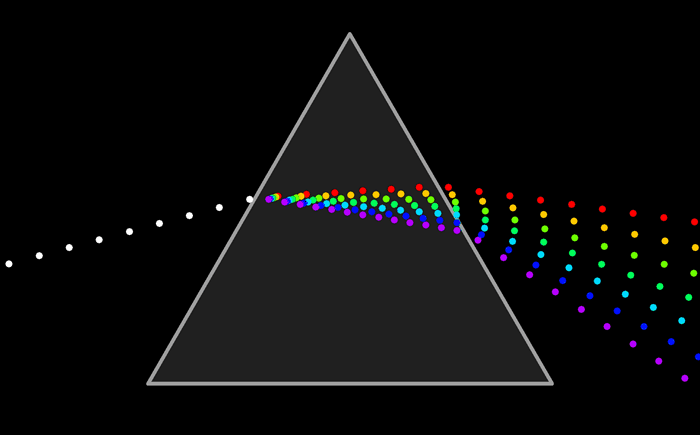File:Light dispersion conceptual.gif
Light_dispersion_conceptual.gif (700 × 435 像素,檔案大小:119 KB,MIME 類型:image/gif、循環、8 畫格、0.8秒)
檔案歷史
點選日期/時間以檢視該時間的檔案版本。
| 日期/時間 | 縮圖 | 尺寸 | 用戶 | 備註 | |
|---|---|---|---|---|---|
| 目前 | 2007年2月24日 (六) 17:28 |  | 700 × 435(119 KB) | LucasVB | Changing "white photons" back to the same size as the colored ones. |
| 2007年2月1日 (四) 17:32 |  | 750 × 498(117 KB) | Leyo | Auf eine alte Version zurückgesetzt | |
| 2007年1月23日 (二) 11:39 |  | 750 × 498(117 KB) | LucasVB | Larger "white" photons may give a better idea of "division of white light". Also, removed magenta color since it is not a spectral color (I don't know why I didn't do this earlier) | |
| 2007年1月21日 (日) 16:54 |  | 700 × 435(121 KB) | LucasVB | Once again, larger (700px), but now a constant stream of "photons", per request. The file is actually smaller now because we just need 8 frames. | |
| 2007年1月21日 (日) 05:01 |  | 450 × 296(379 KB) | LucasVB | Larger size. | |
| 2007年1月20日 (六) 20:52 |  | 250 × 167(265 KB) | LucasVB | Conceptual animation of w:dispersion of light. |
檔案用途
下列頁面有用到此檔案:
全域檔案使用狀況
以下其他 wiki 使用了這個檔案:
- ar.wikipedia.org 的使用狀況
- الكندي
- ضوء
- انكسار (فيزياء)
- غاليليو غاليلي
- تجربة ميكلسون ومورلي
- ازدواجية موجة جسيم
- بوابة:الفيزياء
- ضوء متباطيء
- مقراب
- فوتون
- ليزر
- طيف كهرومغناطيسي
- تجربة الشق المزدوج
- أثر بوكل
- ظاهرة كير
- لون
- موجة كهرومغناطيسية
- إسحاق نيوتن
- قوس قزح
- تدوير ضوئي
- مقياس استقطاب
- منشور نيكول
- علاقة كراميرس-كرونيج
- دليل موجة
- طول الموجة
- نظارة
- تشتت (بصريات)
- جيمس كليرك ماكسويل
- تأثير دوبلر
- ألبرت ميكلسون
- سرعة الضوء
- رينيه ديكارت
- نظارة طبية
- عدسات لاصقة
- ليف بصري
- المناظر
- بصريات
- هنري بيكريل
- بوابة:الفيزياء/بوابات شقيقة
- ظاهرة كهروضوئية
- تخزين بيانات بصرية ثلاثية الأبعاد
- عدسة (بصريات)
- سراب
- قانون بير-لامبرت
- مطيافية
- آندرز أنغستروم
- قنديلة
- لويس دي بروي
- استقطاب (فيزياء)
- إرنست كارل آبي
檢視此檔案的更多全域使用狀況。

